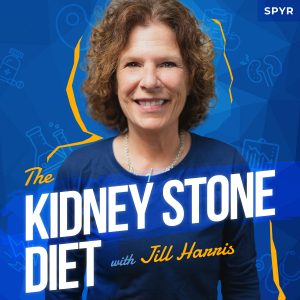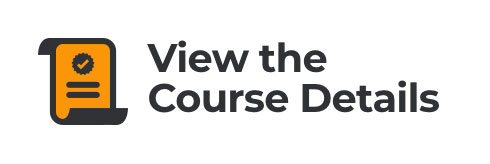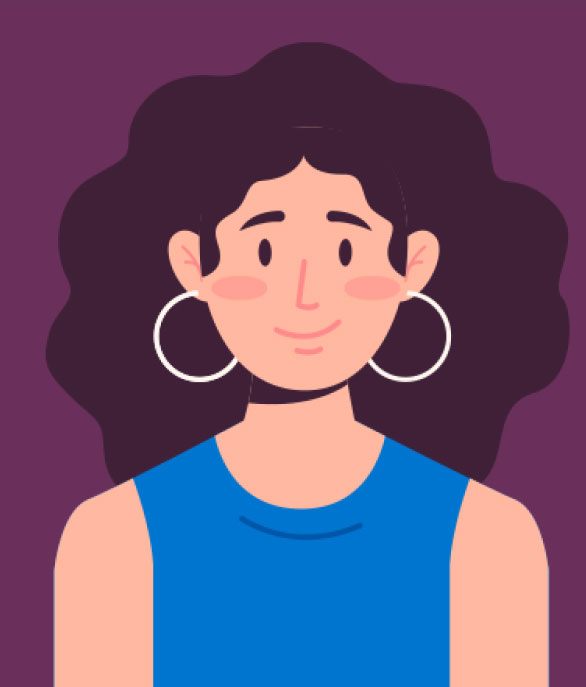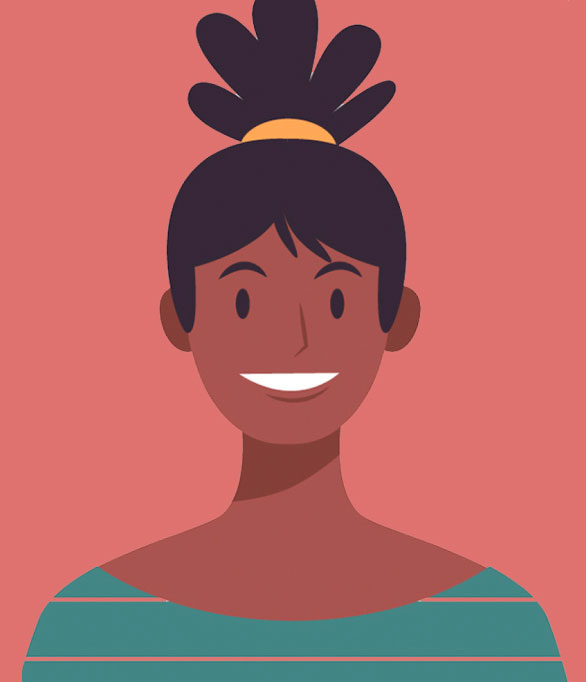This week, Jill answers a listener question about lemon rinds and oxalate.
Jeff Sarris: Welcome back to the Kidney Stone Diet podcast, the show about reducing your kidney stone risk and living your best life. I’m your host and fellow student, Jeff Sarris.
Jill Harris: And I’m Jill Harris, your kidney stone prevention nurse.
We Finally Have Merch!
Jeff Sarris: We were just talking about all the merch that–I don’t know, I’m excited for all of it coming out. I know we talked about it in a past episode, but I’m always changing it up. I don’t! I’m always wearing, basically, the same thing. So it’s all on you so people notice that they’re different episodes.
Jill Harris: Well, yeah, exactly. We all know that I’m gonna get a hoodie. I’m a hoodie girl! I’m definitely gonna get a hoodie. No, I’m gonna get a little bit of everything so we could show it off on the show because people have been screaming for merchandise for the longest time. And we’re always busy educating people and you know, doing, you know, so that has fallen low on the list of things to do. But, you know, it makes people happy and, plus, it keeps them engaged, as well. The hats are super cute. We have “Living your Best Life” t-shirts, hoodies, hats, we have–what is the other one I keep forgetting?
Jeff Sarris: It’s “Don’t judge my joy!”
Jill Harris: Oh, yeah, “Don’t judge my joy!” water bottles, and then the logo, which is the little kidney with the kidney stone on it. Dave put it on the back of the t-shirt. They’re just the cutest because Dave, who is our other partner, there’s three of us here at Kidney Stone Diet–and Amara, so four–he makes all the beautiful art, and graphic design, and all the handouts on the website, and he’s made the t-shirts, too. We’re going to come up with more of them, too, like really popular things that people like, like “Portion, not perfection,” and, you know, “Turn it around, Buster Brown,” when we’re looking at nutrition labels. That kind of stuff. So, yeah, it’s so much fun doing–that’s the fun, the really fun part of you know, it’s just fun. I don’t know. It’s just fun seeing that stuff.
Jeff Sarris: Yeah, it’s like the little side, just a little thing on the side that is purely for fun, just because it’s fun to have it, fun to have other people wearing it. I can’t wait to see people like posting photos in the Facebook group wearing it. And we should do a proper merch photoshoot with you because that would be really fun! Like, have you in everything!
Jill Harris: Yes! I will do it. And also what was I going to say? Oh, I asked Dave to make us like the Kidney Stone Diet goals on a magnet for the refrigerator. That will be a good one, too. All kinds of fun, exciting things, keeping it fresh here at Kidney Stone Diet for us and for you.
Jeff Sarris: Yeah, for sure. Yeah, the core is always education, but adding the little things in there is just stuff to have fun with, a little brainding.
Jill Harris: It’s joyful.
Jeff Sarris: Definitely! So should we dive into this week’s question? We’ve got a question from Karen.
Listener Voicemail
Hi, this is Karen from Hewlett, New York. I have a question about lemons and the lemon rind. I think it’s common knowledge that lemons are good for kidney stones, so I have made lemon water. I fill up a big container of water, and I cut up lemons, and put it in there, and I try to drink that all day. But then I read that the rinds of lemons are high in oxalates, so if I’m putting the entire lemon in the water, am I defeating the purpose of having the lemon by also having the rind in there? Thank you.
Do You Really Need Lemons in Your Water?
Jill Harris: Karen from New York! Yay! I was born in New York, Karen, so I always have a good affiliation with it. Okay, very popular question: lemon rinds, lemon water, and I’m going to start right at the beginning, as one starts, and ask you, do you know if you need lemons? All over the internet, you will see “If you make stones, put lemon in your water. If you make stones, put lemon in your water.” Well, I’m going to, again, go against the grain and say this: Do you know if you need lemons? Are you just generically doing that because lemons prevent kidney stones?
There’s a couple things that really come to my mind right away. Number one, people will start using–and this doesn’t mean you, Karen, I’m just saying what I see everyday–people will start using lemons and thinking now they have done everything they need to do to prevent kidney stones. That’s what people tell me and I’m not making this up. “Jill, well, I was drinking lemon water. Why’d I make four new stones?” Well, because there’s a salt, there’s a sugar, there’s a meat protein, calcium, water, oxalate, there’s a lot of different elements to the whole Kidney Stone Diet. It’s not about lemons.
And, some people, once they do a urine collection, realize that they made things worse, because they increase their pH to a really high level from using all those lemons. Their pH was never low to begin with, so they didn’t need the lemons. So, this is very important. I wouldn’t, generically, do anything until I’ve had a urine collection, except drink water. I can do that. That just means, though, if you’re doing one thing on the Kidney Stone Diet, it doesn’t mean you’re not going to make new stones. You have to do all of them. That’s why they’re so hard.
What About the Lemon Rind?
Get enough calcium every day; drink enough fluids to produce at least two and a half liters of urine; don’t overeat meat protein; keep your sodium level to 1500 to 2000–I give the upper range because if I just say 1500 people will go to 400 I don’t want that. And then added sugar, 25 grams for women, 38 grams for men. 37.5, but nobody likes half numbers, so I just automatically give the guy’s half a point more. So, Kar, let me tell you this: do you have a urine collection, number one? Does it show that you need lemon to increase your citrate in pH? That would be the first thing. Karen’s like, “Did I ask you any of this? Jill, I asked you about the stupid rind! Shut up!”
Alright, alright, alright. I’m getting there. The rind: unless it’s chopped up, Karen, unless you took the grater and went like this in it and you’re taking in the rind, I’m not worried about that, I’m not as far as oxalate is concerned. Yes, is lemon rind higher in oxalate? Yes, it is. But, again, you’re not ingesting the rind. I really don’t think it’s seeping through into your water, quite frankly. So, stay away from rind, people. If you’re, like, using it in baking and you’re putting a little bit on a pie on top, even that you could do it. You’re not eating lemon rind every single day. That’s not happening.
So again, it’s always about portion. So if you were making a lemon meringue pie, and they say lemon zest on tap, enjoy. I’m not worried about the lemon rind in your water. The more important question here is Karen, do you need lemon in your water? That’s the more important question. Let me know in the comments or email me at [email protected]. And let me know if you’ve done a urine collection. And did the doctor tell you to use some lemon? It sounds like to me, but I want to know if you’re just doing that as a generic thing that so many people do. You’re not alone to prevent kidney stones.
Jeff Sarris: Yeah, yeah. And it’s not just a fix-all, unfortunately. It is what we want and that’s why we sort of gravitate towards oxalate and the different things, maybe Chanca Piedra and the various things that feel like this is one and done. I don’t have to think about the rest. But there’s all those different goals, like you say, for very strong reasons for each and every one of them.
A Healthy Lifestyle is a Combination of Many Things, Not Just 1!
Jill Harris: Yes, very strong reasons. And, again, I don’t I never put the blame on the audience or the people I work with, obviously. The diet industry teaches us that instead of just one thing, you just kind of just one thing, just get rid of carbs, just that one thing. It’s a whole food group and it’s a great energy source, by the way, so complex carbs are good for you. You can eat them within portion size, just like everything should be within portion size. But the diet industry has made us believe that it’s always–”Can’t it just be one thing, Jill? Why does it gotta be this five things and then all the other stuff you sprinkle in with all your words? Like why? Why is it all this?” Because that is what is needed for a healthy lifestyle.
It’s not one thing. It’s a lot of different things and this is why it’s overwhelming when people first come to me, but I’ve been doing this so long that I know what people are going to ask. And pretty much I know depending on who I’m talking to, how to give out the information so they can understand it. But it is a lot! I say it all the time. It’s a lot and so we’ve got to change our minds into understanding that it’s never one thing to fix an illness, it’s never one thing to change a diet, it’s never one thing to change a relationship, it’s never one thing to be a better parent. It’s a lot of different things and it’s complicated. And this is why I think a lot of us just sail through life because it’s difficult to incorporate all the changes needed to have a better life. Don’t you think?
It’s work for the rest of your life. And so when people come to work with me, I like to really get that attitude changed right away so they understand that. Otherwise, they’re always going to be, you know, going up this, “Ah, this is so hard!” Once you get the bigger picture, any kind of change is going to be all encompassing, at first, but as you as you learn it all, it just gets so much easier. And that is when it really becomes a lifestyle where, you know, I don’t think too much about the food every day, right? Because I eat a wide variety and I do all the things I teach everybody to do and it really does become your lifestyle. So, then, when you divert from it once in a while, you’re like, “Oh, man, that was really salty. I can’t wait to get back to my lifestyle.”
That’s how this works and anybody that’s been in the Kidney Stone prevention course with me, and in those accountability group calls, we always talk about that. “Oh, Jill, I went on vacation last week, and oh, my God, I had a great time, but I could not wait to get back to my lifestyle.” And I swear, I do not make this up. This is what people say. I say it myself! So when you eat a healthy lifestyle, and you really learn what that means and how to incorporate it all, it really is what you want to do every day. It really is. It’s not hard. It’s not a drudgery. The hardest thing is being consistent at first, but you will get that, too. Practice makes perfect.
Jeff Sarris: Yeah, and it’s that that calibration upfront. It’s sort of a perpetual growth. As a human, we want to get better and better, and every change can feel like a lot. But, with time, like you said, we’re just essentially recalibrating our outlook on what it takes to feel good, to live a better life. So, it does get easier with time. It’s never just a simple cut-and-dry, one-button press, but at the same time, but I think we both agree that it’s worth it.
Jill Harris: It’s so worth it! And again, I don’t know, people will say, “Well, it’s time-consuming.” Anything when you’re learning is time-consuming, at first. Where else would you want to put your time, but to make sure that your body is healthy for you? I always say this, too, it’s like all of a sudden time opens up when you’re sick, meaning you can’t do anything else and you’re gonna have to find the time then. So, let’s do it upfront. Let’s learn how to make our bodies as healthy as it can be–and certainly it’s no guarantee. Illness can come on, but it if you can feed your body, and move your body, and make it work as well as it can for you–just naturally through food and exercise–then if you do happen to also get sick, you’ll be so much stronger going through the things you need to get through to get yourself better, that you’ll be so happy.
There’s nothing worse than being sick and then like, “Oh, now I gotta learn how to eat well, too?” I mean, it’s so all encompassing and anxiety-producing and all of it. So, you know, we we can’t take for granted our body. And, typically, we as human beings do that until something happens. And then we’re like “Uh oh, wake-up call.” And, for kidney stones, it certainly is that for patients, for most patients. But I have to say this, one more thing. Many patients are very upset because they’re like, “I changed my diet. I’m eating healthier. I was a diabetic, I changed everything. Now I’ve got a stone, too?”
Well, you’re eating the same foods over and over in big, large amounts and didn’t understand about getting enough calcium to offset the oxalate–again, complicated–and that’s why you got a stone. So, everything within moderation. I always have a special place in my heart when people say, “Oh my god, I just changed all this. I’m eating healthier than I ever have and, now, are you kidding me? I have a kidney stone!” That happens because, again, people even need to be educated and talk through how do we incorporate healthy foods. The diet industry can say, “Go eat more spinach, but, really, what does that mean for a patient?”
If that’s some something that’s going to help their diabetes, of course, they’re going to overeat. It just makes sense. Or if they’re not eating carbs, they’re going to overeat almonds, right, because that’s what we’re told to do! Not necessarily overeat it, but we didn’t get all the information we need with that: “eat more almonds.” What does more mean? Right?
Jeff Sarris: And I always like when you say, “More healthful food doesn’t mean better health.” Because it’s hard not to. It’s hard not to jump right there. It’s like, “Oh, spinach is good for me, so I should only eat spinach.” But we need that diversity in our diets.
Jill Harris: Wait! I just want to say–
Jeff Sarris: Haha, no, it’s good!
Jill Harris: It’s because–well, now I forgot what I was gonna say–I mean, I don’t know I forgot what I was gonna say.
Jeff Sarris: Diversity in diets?
Jill Harris: Yeah, diversity in the diet….Oh, well, because–thank you, Jeff!–because it is all encompassing and if it’s like, “Okay, I I know my breakfast is oatmeal every year for 20 years. Then I don’t have to think about it. I just do it.” But, again, I’m going to push back and say, “Where else do you want to think about something? Then how are you going to feed this machine? What is it a minute? What else can I have besides oatmeal? Eggs? What else can I have besides oatmeal? Leftover dinner! It doesn’t have to be breakfast food. What else can I have? I could have toast with some berries and some cottage cheese and whatever!” There’s plenty of things, people!
People say, “Well, I know what to do. I have my oatmeal. I don’t have to think about it. Think about how you feed your body, people. Think about it a little bit more. Don’t feed it the same thing every day over and over and over. Okay, I’m done because I wear myself out, people. I know the audience and I know Jeff. When he gets off, he looks at Amara and she’s like, “Thank God, I was in another room. I heard a little bit and I had to leave! It’s too much!”
Jeff Sarris: No, no, no! But touching on changing up the diet, like you just said, that’s why we set up the meal plan. We haven’t talked about that little bit, but the Kidney Stone Diet meal plan, you can find it at kidneystonediet.com. It’s inspiration to show you just how broad the spectrum is of things that you can be eating and not worry so much about removing everything because there’s plenty to eat!
Jill Harris: Yes, people say, “Jill has beans in her meal plan! Has she lost her mind?” Look, the meal plan is very successful because what we’re doing is we’re trying to teach people look at the variety of foods you can have: breakfast, lunch, dinner, a snack every day for seven days. This rotates every week and for $19 a month. Cancel at any time! You get over 100 recipes just if you have it for one month. And the deal is, not only does it come with all different kinds of foods you can have but it also comes with education!
With each recipe I spend a lot of time talking about substitutions or why I did this for kidney stone risks or blah, blah, blah, blah, blah. So it’s, again, another way to get information, but it’s been very helpful for patients because they just don’t know where to start. And the recipes that I’m cooking for myself are what’s in the meal plan. Simple! Nothing’s more than 30 minutes. You have it for a couple nights, so you don’t even have to worry about it and it’s all Kidney Stone Diet safe: the salt, the calcium, the sugar, the oxalate is all counted out for you, so you do not have to worry, period. It’s a wonderful service for people. Very cheap, might I say?
Jeff Sarris: Yeah, and again, that’s at kidneystonediet.com and you’ll find everything there. Oh, and if you have a question, the number again is 773-789-8763. But with that, I think we’ll wrap and see everyone next week!
Jill Harris: Thanks, Karen! Great question, Karen from New York!














Leave a Reply